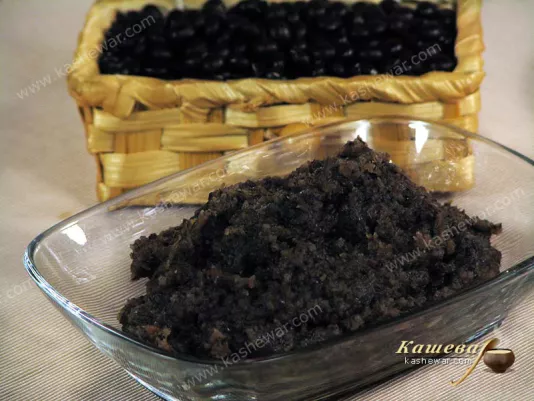Red Fish in Rice Paper
Red fish in rice paper is an incredibly tasty and juicy fish with two types of sauce.

Soybean paste is a versatile ingredient widely used in world cuisine for its rich flavor and nutritional properties. I have often used it in soups, sauces, and even marinades, and I can confidently say that this paste can turn simple ingredients into a refined dish. It is produced by fermenting soybeans, which ensures its characteristic umami aroma and depth of taste that is hard to replace with other seasonings. Soybean paste not only enhances the taste of vegetables, meat, or fish but also pairs perfectly with noodles, rice, and salads. Especially valuable is its high content of protein, fiber, and essential trace elements, which make it not only tasty but also beneficial. In my cooking practice, it is indispensable when I need to quickly give a dish a deep flavor without adding a large number of spices.
Soybean paste has a centuries-old history and originates from East Asian countries, where it has long been an essential part of the daily diet. In China, Korea, and Japan, fermented soybean paste was traditionally used as a base for soups, sauces, and seasonings. It was considered not only a culinary product but also a source of beneficial nutrients that promote health. I have often noticed that even a small amount of soybean paste can give dishes a deep umami flavor, making them more balanced and pleasant to the taste. In Korea, soybean paste is known as doenjang and is used to prepare hearty soups served daily. In Japan, miso is more common, with different degrees of fermentation and varying flavor profiles, from mild and delicate to intensely rich. In modern global cuisine, this product has long gone beyond its regional origins and is actively used in restaurant menus across Europe and America. It helps chefs create harmonious sauces, marinades, and soups, while also serving as a foundation for new culinary experiments.
Soybean paste is distinguished by its high content of plant-based protein, making it an indispensable product for people who want to reduce meat consumption or follow vegetarian and vegan diets. In addition to protein, it contains amino acids that are easily absorbed by the body and support muscles and energy throughout the day. I have often noticed that dishes with soybean paste keep the feeling of satiety longer than light vegetable soups or salads. The paste also contains fiber, which supports digestion and helps normalize gut microflora. Fermentation enriches the product with beneficial bacteria that act like probiotics. The paste also provides B vitamins for the nervous system, as well as calcium, iron, and magnesium essential for bones and blood circulation. This ingredient helps maintain dietary balance, and thanks to its moderate salt content, it can replace traditional seasonings, making dishes less harmful for the heart and blood vessels.
Soybean paste comes in many varieties that differ in fermentation level, composition, and even color. The most well-known variety is Japanese miso, which can be white, red, or dark. White miso has a delicate, mild flavor and is suitable for light soups and sauces. Red miso has a stronger aroma and saltiness, while dark miso has a rich flavor with deep umami notes, usually used in dishes with meat or seafood. In Korea, doenjang is traditionally widespread; it has a thick consistency and pronounced aroma, making it perfect for hearty soups, braised vegetables, and meat sauces. In China, soybean paste with added wheat is also common, giving it a softer, slightly sweet taste. In my culinary practice, different types of soybean paste open wide opportunities for experimentation: they can be combined with noodles, added to salad dressings, or used in marinades. Each type of paste reveals its unique flavor range and allows the creation of dishes suited to different preferences.
Soybean paste has become an integral part of world cuisines and is used not only in Asia but also in many other regions. In Japan, it is the base of the famous miso soup, often served as a first course at lunch or dinner. In Korea, doenjang is used for rich jjigae soups that combine vegetables, seafood, or meat. Chinese chefs add the paste to noodle and vegetable dishes, creating sauces with a deep taste and light caramel notes. In European cuisine, this ingredient is increasingly used to prepare marinades for chicken, beef, and fish, as it perfectly enhances the natural flavors of food. I often use soybean paste in my own recipes to make salad dressings, since even a small amount gives them an interesting piquancy. It also works well with garlic, ginger, sesame oil, and citrus juices, allowing the creation of versatile dressings. Soybean paste has successfully integrated into modern gastronomy and has become an essential ingredient for chefs looking to experiment and go beyond traditional recipes.
To preserve its aroma and beneficial properties, soybean paste should be kept in a tightly sealed container in the refrigerator. Thanks to fermentation, this product can be stored for quite a long time, but I always recommend using it within a few months after opening to keep the flavor as rich as possible. When working with soybean paste, it is important to consider its pronounced saltiness: when adding it to soups, sauces, or marinades, I always start with a small amount and then adjust the taste gradually. For everyday cooking, half a teaspoon is enough for a serving of soup, while for marinades or sauces, the amount can be increased depending on the desired intensity. The paste pairs excellently with garlic, chili, sesame, and vegetables, allowing the creation of both mild and spicy dishes. At home, I like to experiment by adding it to salad dressings or grilled dishes, where soybean paste brings out its umami effect. By following simple storage rules and approaching dosing carefully, this ingredient will become a real treasure in your kitchen.